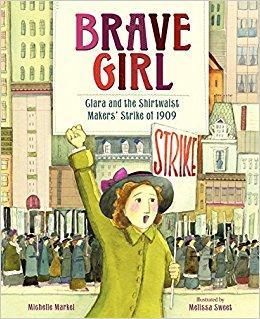
Brave Girl
Read Aloud Book: Brave Girl
Story: Michelle Markel
Illustration: Melissa Sweet
ISBN-13: 978-1629238340
C3 Framework Key term: Unemployment: A condition where people at least 16 years old are without jobs and actively seeking work.
Handouts
Language Barriers in the Workplace (PDF version only)
Download and Print the PDF
Synopsis
Clara Lemlich is a young immigrant girl who comes to New York with her family. She becomes a garment worker and works alongside other immigrant girls to make clothing. These girls work long hours and are paid very little. Clara urges other workers to fight for their rights. She motivates women to protest factory conditions. Note: Educators may show the documentary, Clara Lemlich, by Icarus Films.
Discussion
Provide a historical summary: In 1909, Clara Yemplich helped to set off strikes of young women garment workers. These strikes spread from New York to other big cities including Philadelphia, Cleveland, and Chicago. Some manufacturers increased the wages of the workers. In the vast majority of cases, the wage increases were small and other working conditions, including safety, did not improve. Ask: Think about Clara’s speech at the union meeting. What is notable about her behavior? Say: Before Clara, both men and women unions did not believe that young immigrant workers could sustain a strike. They thought that being a woman, young, and in desperate need of income, would end the strike almost immediately. Ask: In what ways was the 1909 strike an important milestone in history?
Ethics Connection
Say: Two years later, on March 25, 1911, a tragedy happened in the Triangle Shirtwaist factory. This factory employed about 700 workers, most of them were young immigrant women. The workers spent 13-hour days at the factory in crowded conditions and made $6 a week. The supervisors locked the doors from the outside. There was almost no ventilation, and the walls and ceilings were covered with fabric and completed shirtwaists. The fire spread quickly. There was only one fire escape, which collapsed. Machines and tables blocked exit routes. The fire killed 146 women and girls. Write on the board: “Employer Responsibility.” Say: In groups, create a poster that lists and illustrates the actions that employers should take to protect their workers. Consider employees’ needs, including translation to multiple languages and conducting fire drills to ensure all safety conditions are met. You may use the summary of safety laws on the US Department of Labor website and add your ideas to the list. Conclude by pointing at the virtues represented by safety ethics including value for human life, commitment to protecting the well-being of others, compassion, fairness, and accountability.
Fun Activity
Say: Many of the garment workers in the early 1900’s were immigrants who could not communicate effectively about their working conditions to people who didn’t speak their language. Employers used this language barrier to exploit immigrant labor. This activity will help you understand the difficulty of language barriers. Distribute the attached worksheets and ask students to simulate the experience of new immigrants in a factory. When everyone is done, invite students to compare their understanding of the instructions, and to share the insights they have gained from the activity.